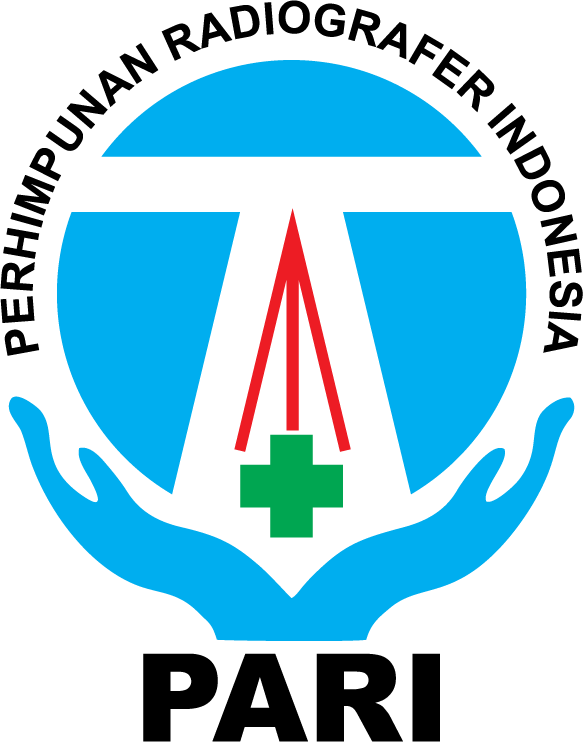CR Image Optimization and Radiation Dose Limitation With Collimation Adjusting on Cervical Radiography
Abstract
Background: Radiological examination in cervical services, Radiographers often opening the collimation wider of the size of the imaging plate for fear of being cut. This is done because it is supported by the image cropping facility on the CR. So there is a habit of opening the collimation width as wide as the imaging plate, which is often done with the assumption that it is better to widen the collimation than cut off the object. Obviously this will increase the radiation dose in patients with basic limitations. According to ICRP, patient safety must refer to the principle of radiation protection ALARA namely in the shortest possible time to get quality radiographs and patients receive the most minimum radiation exposure as possible.
Methods: This research is a descriptive analytic research conducted with a cross sectional approach. The study was conducted by varying the radiation field area to be used for cervical examination. There are 10 variations of collimation area with 3 (three) exposures in each collimation. Then measured contrast, noise and radiation dose. Radiation dose is calculated by means of a babyline device.
Results: The results showed that the collimation setting did not affect contrast radiography in CR because collimation was not the main factor that could affect contrast radiography on CR. The collimation setting on cervical radiography has an effect on the radiation dose, so it is necessary to adjust the collimation to get the minimum dose possible. The most optimal collimation area on cervical radiographic examination was obtained at a size of 12 x 24 cm with the smallest noise reception and dose compared to others and had higher contrast. Average contrast value achieved was 0.45 with a dose of 39.23 µGy.
Conclusion: The collimation setting on cervical radiography has an effect on the radiation dose, so it is very necessary to adjust the collimation to get the minimum dose possible. The most optimal collimation area on cervical radiographic examination is obtained at a size of 12 x 24 cm with the smallest noise reception and dose compared to others and has a higher contrast.Keywords
Full Text:
PDFReferences
Alsleem, H., Davidson, R., Al-Dhafiri, B., Alsleem, R., & Ameer, H. (2019). Evaluation of radiographers’ knowledge and attitudes of image quality optimisation in paediatric digital radiography in Saudi Arabia and Australia: a survey-based study. Journal of Medical Radiation Sciences, 66(4), 229–237. https://doi.org/10.1002/jmrs.366
Ballinger, P. W., & Frank, E. D. (2013). Merrill’s Atlas of Radiographic Position. In Journal of Chemical Information and Modeling (Vol. 53, Issue 9). https://doi.org/10.1017/CBO9781107415324.004
BATAN. (2012). BATAN Chairman Regulation No. 020/KA/I/2012 On Guidance of Occupational Healt And Safety Risk Assessment.
Ferreira, T., & Rasband, W. (2012). ImageJ User Guide User Guide ImageJ. Image J User Guide, 1.46r. https://doi.org/10.1038/nmeth.2019
Hiswara, E., & Kartikasari, D. (2015). Dosis Pasien Pada Pemeriksaan Rutin Sinar-X Radiologi Diagnostik. Jurnal Sains Dan Teknologi Nuklir Indonesia, 16(2), 71. https://doi.org/10.17146/jstni.2015.16.2.2359
ICRP. (2007). The 2007 Recommendations of the International Commission on Radiological Protection. ICRP publication 103. Annals of the ICRP, 37(2–4), 1–332. https://doi.org/10.1016/j.icrp.2007.10.003
J. Anthony Seibert (Chair), Bogucki, T. M., Ciona, T., Huda, W., Karellas, A., Mercier, J. R., Samei, E., Shepard, S. J., Stewart, B. K., Strauss, K. J., Suleiman, O. H., Tucker, D., Uzenoff, R. A., Weiser, J. C., & Willis, C. E. (2006). Acceptance Testing and Quality Control of Photostimulable Storage Phosphor Imaging Systems. In 93 (Issue 93).
Lampignano, J. P., & E.Kendrick, L. (2018). Bontrager’s Textbook of Radiographic Positioning and Related Anatomy. ELSEVIER.
Rochmayanti, D., Darmini, D., & Jannah, M. (2018). Faktor Determinan Kolimasi, Ukuran Imaging Plate Dan Delay Time Processing Terhadap Exposure Index. Jurnal Riset Kesehatan, 6(2), 1. https://doi.org/10.31983/jrk.v6i2.2910
Seibert, J. A. (2008). Digital radiography: Image quality and radiation dose. Health Physics, 95(5), 586–598. https://doi.org/10.1097/01.HP.0000326338.14198.a2
Strauss, L. J., & Rae, W. I. (2012). Image quality dependence on image processing software in computed radiography. South African Journal of Radiology, 16(2), 44–48. https://doi.org/10.4102/sajr.v16i2.305
DOI: https://doi.org/10.31983/jimed.v8i1.8259
Article Metrics
Refbacks
- There are currently no refbacks.
JURNAL IMEJING DIAGNOSTIK by http://ejournal.poltekkes-smg.ac.id/ojs/index.php/jimed is licensed under a Creative Commons Attribution-ShareAlike 4.0 International License.

.png)
.png)
.png)
.png)
.png)
.png)
.png)











